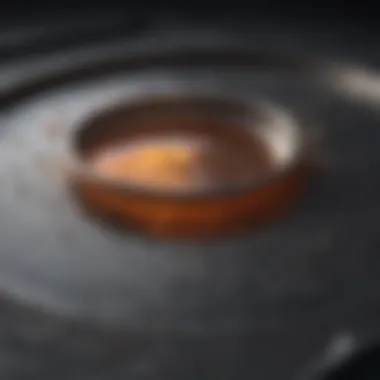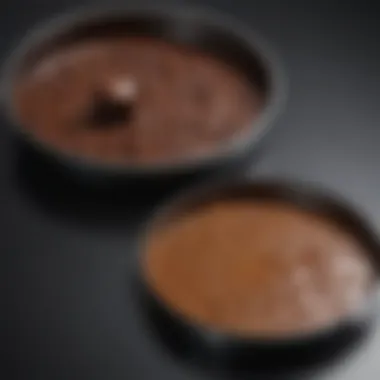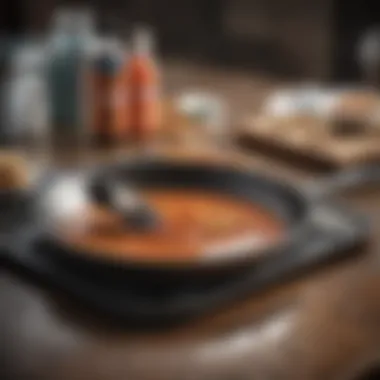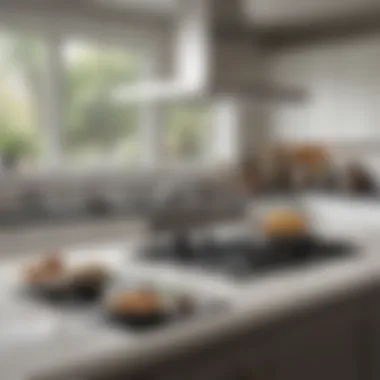A Complete Guide to Cleaning Your Drip Pans Effectively


Intro
Cleaning drip pans is a crucial, yet often overlooked, aspect of kitchen maintenance. Drip pans are located underneath cooking appliances, capturing spills and drips from cooking processes. While they serve a practical purpose, neglected drip pans can lead to unpleasant odors, pest infestations, and even appliance malfunctions. This guide dives into the importance of cleaning these often-forgotten components, types of drip pans, effective cleaning methods, and preventative measures to keep them in optimal condition.
Understanding the significance of maintaining clean drip pans goes beyond aesthetics. It contributes to a healthy cooking environment, ensuring that food preparation stays safe and hygienic. When drip pans collect residue and grease, they become sources for bacteria growth, which can transfer onto food. Therefore, regular cleaning is necessary for both the longevity of your appliances and the safety of your culinary creations.
This guide will provide the reader with detailed insights into various cleaning techniques. We will explore the materials involved in drip pans and suggest practical solutions tailored for various cleaning needs. With a focus on comprehensive methods and effortless upkeep, this resource aims to enhance your culinary experience and help your kitchen appliances function efficiently.
Understanding Drip Pans
Understanding drip pans is essential for anyone who values cleanliness in their kitchen. Drip pans serve multiple functions in various appliances, and knowing their specific roles can lead to better maintenance and efficiency of equipment. By grasping what drip pans are and how they work, users can appreciate their importance far beyond mere decoration.
Definition of Drip Pans
Drip pans are shallow containers designed to catch liquid drips from cooking appliances, such as stovetops, ovens, and refrigerators. They trap spills, prevent messes from reaching bottom surfaces, and protect appliances from damage due to spills. Without them, cooking would become more chaotic, leading to a less pleasant experience.
Functionality of Drip Pans
Drip pans function primarily to contain spills and overflow, simplifying the cleaning process. In stovetops, they capture grease and food particles, which could otherwise lead to smoke or unpleasant smells during cooking. In ovens, drip pans prevent drips from reaching the heating elements. This not only preserves appliance integrity but also maintains a healthier cooking environment. Finally, in refrigerators, they manage excess moisture, thus preventing leaks onto cabinet floors and ensuring refrigeration efficiency.
Common Types of Drip Pans
Understanding the different types of drip pans allows users to better utilize them based on specific needs. Each type has unique characteristics and functions, enhancing their role in keeping the kitchen clean and efficient.
Stovetop Drip Pans
Stovetop drip pans are often made from metal or porcelain. They collect grease and food particles that fall during cooking. This is crucial for avoiding smoke and unpleasant odors when the stovetop heats up. The key advantage of stovetop drip pans is their ability to be cleaned easily, reducing the hassle associated with kitchen cleanup. However, users should be careful as some materials might be prone to scratches or wear over time.
Oven Drip Pans
Oven drip pans are placed underneath the oven cavity to catch spills from roasts or baked goods. They are usually shallow and designed for easy removal. A primary feature of oven drip pans is their heat resistance, making them reliable for high-temperature cooking. Their effectiveness lies in simplifying cleaning tasks. While they are generally durable, they require regular cleaning to avoid built-up grease that can lead to smoke during cooking.
Refrigerator Drip Pans
Refrigerator drip pans are located beneath the refrigerator and collect excess moisture. This prevents water from leaking onto the floor and accumulating, which could lead to mold growth. The patent feature of these pans is their ability to maintain a dry environment, which contributes to appliance efficiency. However, they often go unnoticed and are sometimes neglected, which can lead to odors and health concerns. Regular maintenance is important to avoid problems.
Importance of Cleaning Drip Pans
Cleaning drip pans is not just a matter of aesthetics; it plays a crucial role in the overall health, efficiency, and longevity of your kitchen appliances. Drip pans, often overlooked and neglected, collect grease, food spills, and other residues over time. If left uncleaned, these substances can lead to various issues, impacting both your cooking experience and the functionality of your appliances.
Health Considerations
The buildup of grime in drip pans can become a breeding ground for bacteria and mold. Food particles and grease attract pests, which can lead to contamination of your food. By maintaining clean drip pans, you reduce the risk of foodborne illnesses. When cooking, any old residue can transfer unwanted flavors or toxins to your meals. This poses health risks that can easily be avoided with regular cleaning. Ensuring cleanliness in these areas is not just about hygiene; it is about fostering a safe environment for food preparation.
Performance and Efficiency
When drip pans are dirty, they can severely affect how your stovetop and oven operate. In the case of stovetop pans, accumulated grease can hinder heat distribution. This results in uneven cooking or longer cooking times. Similarly, oven drip pans can obstruct airflow or cause heat retention issues, which may again lead to inefficient cooking. Regularly cleaning drip pans ensures that these appliances can work at their best, thus optimizing your kitchen performance and saving energy in the process.
Prolonging the Life of Appliances
Appliances represent a significant investment in any kitchen, and proper maintenance is essential to prolong their lifespan. Over time, built-up grime and spills can cause corrosion or damage to heating elements. This leads to the need for more frequent repairs or early replacements. By committing to a routine cleaning schedule for your drip pans, you help safeguard your appliances from avoidable wear and tear. This not only saves money in the long run but also ensures your kitchen functions smoothly for years to come.
"Regular cleaning is key to maintaining both the performance and lifespan of your kitchen appliances."


Gathering Necessary Supplies
Gathering the necessary supplies is a crucial step in the process of cleaning drip pans. Having the right tools and cleaning agents not only makes the task easier but also ensures that the drip pans are cleaned effectively. This section discusses the vital components that will help achieve optimal cleaning results.
Recommended Cleaning Agents
Choosing the appropriate cleaning agents is key to removing stubborn stains and burnt-on residue from drip pans. Here are some commonly recommended options:
- Dish Soap: A basic yet effective cleaner, dish soap cuts through grease and food particles easily. It is safe to use on almost all surfaces and is readily available.
- Baking Soda: This is a versatile agent often used for tough stains. It acts as a mild abrasive that can help lift grime without scratching the surface of the pans.
- Vinegar: Known for its natural deodorizing and descaling properties, vinegar can address odors and mineral buildup effectively.
- Commercial Cleaners: Products designed specifically for kitchen cleaning can also be used, but it is essential to check the labels for compatibility with the type of material used in the drip pans.
Tools for Effective Cleaning
Tools play a significant role in how thoroughly the drip pans can be cleaned. Here are a few essential tools for effective cleaning:
Scrubbers
Scrubbers are essential in the cleaning process. Their rigid structure allows for removing tough stains and residual grease. They can be made of various materials, such as stainless steel or nylon, and each type has advantages and disadvantages.
A key characteristic of scrubbers is their ability to withstand scrubbing pressure, which is crucial for cleaning burnt-on food. However, one must be cautious with non-stick pans, as certain scrubbers might scratch or damage the surface.
Sponges
Sponges are another popular choice for cleaning drip pans. They are soft and versatile, making them suitable for various surfaces. Sponges can absorb a significant amount of cleaning solution, helping to lift stuck-on debris without excessive scrubbing.
The unique feature of sponges is their ability to be used on both rough and smooth surfaces. This adaptability makes them a beneficial option. However, sponges can retain odors and bacteria if not cleaned properly after use.
Old Toothbrushes
Old toothbrushes can be an exceptionally handy tool for getting into tight spaces and crevices. Their small bristles make them effective at scrubbing areas where larger tools might not reach, thus enhancing the overall cleaning process.
Toothbrushes are an eco-friendly choice, allowing one to reuse an item that would otherwise be discarded. However, it is vital to ensure they are cleaned before and after use to avoid cross-contamination.
Using quality cleaning supplies and tools not only saves time but also extends the life of your drip pans and appliances.
In summary, gathering the necessary supplies along with knowing how to use them effectively will streamline the cleaning process. The right cleaning agents and tools, such as scrubbers, sponges, and toothbrushes, contribute meaningfully toward achieving cleaner, healthier drip pans.
Step-by-Step Cleaning Process
Cleaning drip pans might seem trivial, but a systematic approach can significantly enhance their longevity and effectiveness. A step-by-step cleaning process ensures no area is overlooked, leading to a more thorough clean. This is particularly essential for appliances that face regular residue build-up, like stovetops and ovens. The method discussed here simplifies the task while focusing on efficiency, ensuring that even the most stubborn grime doesn’t mar your kitchen experience.
Preparation Before Cleaning
Before diving into the cleaning process, gather essential tools and products. Start by unplugging your appliances to ensure safety. Remove the drip pans from their respective positions. This makes the cleaning much more efficient. Place the pans in a spacious area where you can easily move around and access supplies.
The following items will be beneficial:
- Rubber gloves to protect your hands.
- Mild detergents suitable for kitchen use.
- Soft cloths and scrubbing pads to prevent scratches.
- Basin or bucket for soaking.
Have these supplies ready. Taking this step ensures that your cleaning session is smooth and organized.
Initial Soak for Stubborn Residue
Soaking is an effective method to tackle tough stains. Fill a basin with warm water and add a few drops of a mild detergent or a natural cleaning agent like vinegar. Immerse the drip pans in the solution for about 15 to 30 minutes.


This process allows the detergent to penetrate the grime. It helps loosen stubborn residue that can otherwise be difficult to remove. After soaking, you may notice that some stains have already started to lift. It softens the tough spots, making the following scrubbing much easier.
Scrubbing Techniques
Once the drip pans have soaked, it's time to scrub. Use a non-abrasive scrubber or a soft cloth to wipe down the surfaces. Focus on areas with visible stains and built-up residue. For corners or tight spots, an old toothbrush can be very effective.
Make sure to apply even pressure. Avoid over-scrubbing, which can damage the pans. Structural integrity can be compromised if too much force is used. Pay attention to ensure that all remnants of food are cleaned away. Rinse your cleaning tool periodically to avoid redistributing dirt.
Rinsing and Drying
After scrubbing, it is crucial to rinse the drip pans thoroughly. Use warm water to wash away any soap or residue left from the cleaning agents. Ensure there are no traces of detergent remaining, as this can affect the performance of your appliances.
Once rinsed, shake off excess water and place the pans on a clean towel or drying rack. Allow them to air dry completely. This step is vital as improper drying can lead to rusting or new stains forming. Make sure they are completely dry before reinstalling them back into your appliance.
Proper cleaning not only prolongs the life of your appliances but also enhances their performance.
Following these steps creates a structured framework for cleaning drip pans. Each part of the process plays a crucial role in maintaining the kitchen appliances and promotes a cleaner cooking environment.
Using Natural Cleaning Alternatives
Utilizing natural cleaning alternatives offers an effective and eco-friendly approach to maintaining clean drip pans. These methods not only provide substantial cleaning power but also minimize the exposure to harsh chemicals found in many commercial cleaners. By opting for natural ingredients, one can achieve remarkable results while promoting a healthier kitchen environment. This section will explore three prominent natural cleaning agents: baking soda, vinegar, and lemon juice. Each has unique benefits and applications that cater specifically to the challenges of cleaning drip pans.
Baking Soda as a Cleaning Agent
Baking soda is well-known for its versatility in cleaning. This white powder works as a gentle abrasive, helping to remove grime without scratching surfaces. When used on drip pans, it can effectively lift stubborn stains and burnt residues. To use baking soda, a common method involves creating a paste by combining it with water. Apply this mixture generously to the drip pan, allowing it to sit for at least 15–30 minutes before scrubbing. This step lets the baking soda penetrate and loosen dirt, making it easier to clean. In addition, baking soda can neutralize odors, which is beneficial for a clean kitchen environment.
Vinegar for Stubborn Stains
Vinegar is another exceptional natural cleaning option. Its acidic properties allow it to dissolve grease and grime effectively. When facing particularly stubborn stains, consider mixing equal parts of vinegar and water in a spray bottle. This solution can be sprayed directly onto the affected areas of the drip pan. After letting it sit for a few minutes, scrub the mixture with a sponge or brush, and rinse thoroughly. The vinegar not only helps remove stains but also leaves surfaces shiny, enhancing the overall appearance of the drip pans.
"Vinegar and baking soda can create a bubbly reaction that boosts cleaning power, especially for tough builds up!"
Lemon Juice for Freshness
Lemon juice, known for its natural antibacterial qualities, provides an alternative to commercial disinfectants. Its citric acid is effective in cutting through grease and removing stains. For cleaning drip pans, apply fresh lemon juice to the stained areas. Combine it with a sprinkle of baking soda for enhanced effect. After applying the lemon juice, scrub the surface to lift stubborn residues. Besides its stain-fighting capabilities, lemon juice imparts a fresh scent, leaving the kitchen smelling pleasant after cleaning.
In summary, using natural cleaning alternatives is an efficient and mindful decision for maintaining drip pans. Baking soda, vinegar, and lemon juice not only serve the primary purpose of cleaning but also promote a healthier home without the drawbacks of chemical cleaners. Embracing these natural options can contribute to a more sustainable lifestyle while ensuring that kitchen appliances function optimally.
Preventative Measures for Drip Pan Maintenance
Maintaining drip pans is as essential as cleaning them. Preventative measures can significantly reduce the frequency and intensity of cleaning required over time. These strategies not only keep the pans looking better but also enhance the overall performance of kitchen appliances. Focusing on regular upkeep can lead to smoother cooking experiences and help avoid potential appliance issues later on.
Regular Cleaning Schedule
Adopting a regular cleaning schedule is vital for upkeep. Establishing a habit of checking and cleaning drip pans minimizes grease and residue build up. It is practical to incorporate this into your routine. A simple weekly check can save you from dealing with stubborn stains.
- Set aside specific days for cleaning. For instance, choose a day when you normally clean the kitchen.
- Keep track of any spills or messes that occur. Address these immediately to prevent them from hardening.
- Consider using a calendar reminder on your phone for weekly cleaning tasks.
A consistent schedule ensures that every buildup is manageable. It can drastically cut down the time spent on extensive cleaning efforts.
Using Liners for Drip Pans
Using liners is a straightforward preventative measure. These protect your drip pans from direct contact with spills and drips. Liners can be found in various materials, including aluminum foil or disposable sheets that are made for this purpose.


Benefits of using liners include:
- Ease of cleaning: Simply replace the liner instead of scrubbing the pan.
- Cost-effective: It's often cheaper to use a liner than to replace a pan entirely.
- Time-saving: Less scrubbing and cleaning means you spend less time in the kitchen.
Liners can be particularly helpful if you regularly cook dishes that might overflow or splatter. Use them to make cleaning much more manageable.
Monitoring Appliance Usage
Lastly, monitoring how you use your appliances can greatly influence drip pan maintenance. Being mindful of your cooking habits helps to avoid excessive spills that lead to buildups.
- Opt for using lids when cooking to reduce splatter.
- Avoid overfilling pots and pans. This not only helps in preventing spills but also ensures culinary safety.
- Be conscious of time; cooking at lower temperatures often results in less smoke and mess.
By being proactive about appliance usage, you can reduce the amount of residue that ends up in the drip pans. This mindful approach fosters longevity for both the drip pans and the appliances.
"Preventative measures today lead to fewer hassles tomorrow."
Troubleshooting Common Issues
Cleaning drip pans can sometimes present complications that require additional attention. Understanding common issues, such as persistent stains and burnt residue, is paramount for maintaining kitchen appliances. Addressing these problems effectively not only enhances the aesthetic appeal of your kitchen but also improves the performance of the appliances. This section delves into two specific challenges faced by many in the cleaning process, offering practical solutions and helpful insights.
Persistent Stains
Persistent stains on drip pans are a common frustration. These can arise from food spills, grease buildup, and even from long-term neglect. It is important to recognize that stains do not just affect appearance; they can also harbor bacteria and make subsequent cleaning more difficult.
To manage persistent stains, consider the following steps:
- Assess the Stain: Identify the type of stain you are dealing with. Different stains may require specific cleaning agents or techniques.
- Soak the Pan: For tough stains, soaking the drip pan in a mixture of hot water and dish soap can be effective. Allow it to soak for at least 30 minutes before attempting to scrub.
- Use Baking Soda: Baking soda, when applied directly to the stain and moistened, can help lift tough spots. Let it sit for a while before scrubbing.
- Gentle Scrubbing: Employ a soft scrub brush or sponge to avoid scratching the surface, focusing on stained areas. Using an old toothbrush can help reach into crevices.
If the stain persists, consider using a mixture of vinegar and baking soda, which can create a powerful cleaning reaction. Always rinse thoroughly afterward to ensure no residues remain.
Burnt Residue
Burnt residue is another common issue that arises, especially in stovetop drip pans. This buildup can be a result of high cooking temperatures and prolonged exposure to spilled food. Burnt residue not only looks unappealing but can also affect the heating efficiency of the appliance.
Addressing burnt residue requires a different approach:
- Initial Scraping: Gently scrape the burnt area with a plastic spatula or scraper. This will help to dislodge the most impacted parts of the residue.
- Apply a Cleaning Paste: Combine baking soda with water to form a thick paste. Apply this paste directly to the burnt areas and let it sit for several hours or overnight.
- Use Vinegar for Extra Power: After the paste has set, spray some vinegar on the area. This combination can help break down the burnt residue effectively.
- Final Scrubbing: After the paste and vinegar treatment, scrub with a soft brush or sponge. Pay particular attention to the corners and edges where residue may accumulate.
Keep in mind that prevention is key. Regularly cleaning drip pans can greatly reduce the occurrence of both persistent stains and burnt residues, making the cleaning process more manageable in the long run.
Epilogue
Cleaning drip pans is not just a matter of aesthetics but also plays a significant role in maintaining the efficiency of kitchen appliances. A clean drip pan helps in avoiding any potential health hazards that may arise from bacteria and food residues accumulation. By keeping these components clean, you are ensuring your appliances operate smoothly and effectively. This ultimately minimizes energy consumption, enhancing their performance and extending their lifespan. Regular attention to this often-overlooked task contributes to a more pleasant cooking environment and can elevate your overall culinary experience.
Recap of Cleaning Importance
We discussed several reasons why regular cleaning of drip pans is essential. From health considerations to maintaining appliance efficiency, the importance of this task cannot be overstated.
- Health Considerations: Bacteria can thrive in dirty drip pans, posing a risk to food safety.
- Performance and Efficiency: Clean drip pans help appliances function at their best, avoiding unnecessary strain.
- Prolonging Appliance Life: Regular cleaning can help avoid costly repairs or replacements caused by buildup.
By taking the time to clean your drip pans, you are investing in both your health and the longevity of your kitchen appliances.
Final Recommendations
To make cleaning drip pans an effortless part of your kitchen maintenance routine, consider the following:
- Establish a Regular Cleaning Schedule: Set specific times to clean drip pans, such as weekly or bi-weekly.
- Use Natural Cleaners: Options like baking soda, vinegar, and lemon juice not only clean effectively but are also eco-friendly.
- Invest in Quality Tools: Ensure you have suitable scrubbers and sponges ready for the task.
- Employ Liners: Using drip pan liners can reduce the frequency of necessary cleanings and protect the pans from stubborn stains.
Cleaning drip pans may seem trivial, yet it has substantial benefits. By incorporating these practices into your routine, you can maintain a tidy kitchen and efficient appliances.















